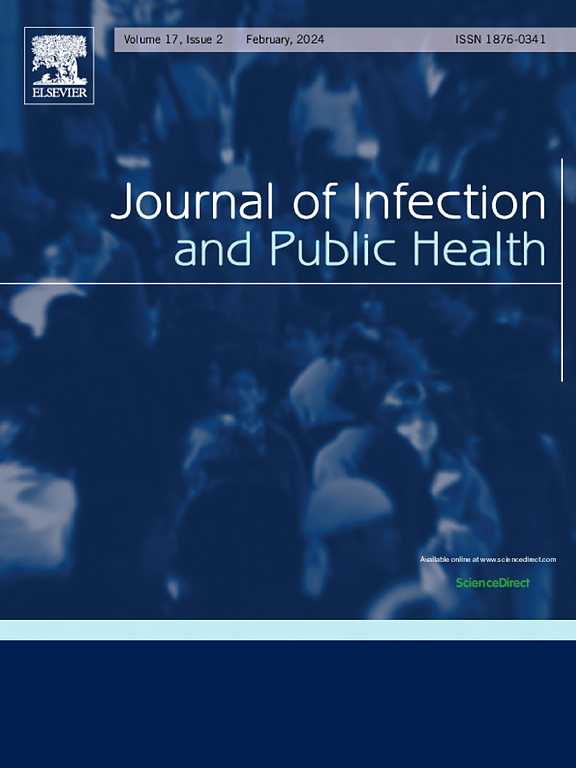侵袭性分离曲霉的流行病学特征:形态、药物敏感性和唑类药物靶点突变。
IF 4.7
3区 医学
Q1 INFECTIOUS DISEASES
引用次数: 0
摘要
背景:全球曲霉病流行病学各不相同,受多种因素影响。为明确疾病负担和确定有效的控制策略,有必要对曲霉感染的流行病学特征进行调查。本研究旨在了解中国北方某大型三级医院不同曲霉种类的流行病学特征,包括形态特征、种类鉴定和对9种抗真菌药物的体外敏感性。方法:收集临床分离的95株曲霉。采用传统形态学方法、MALDI-TOF质谱和基因测序进行曲霉种类鉴定。使用Sensititre YeastOne系统评估对9种抗真菌药物的体外敏感性。采用Sanger法对A. tubinazole靶基因cyp51A和cyp51b进行测序。结果:烟曲霉、黑曲霉、黄曲霉、塔冰曲霉、土曲霉是最常见的分离种。稀有种有柽柳曲霉、usamil曲霉、花色曲霉、udagawae曲霉、香菇曲霉、西多曲霉、四线曲霉等。肺部感染占收集病例的86.3%(82/95),住院死亡率为22.1%。两性霉素B的中位最小抑制浓度(MIC)范围为1.5 ~ 4 mg/L。三唑对不同种类曲霉(不包括乌达曲霉和香菇曲霉)的MIC范围为0.12 ~ 0.5 mg/L。结论:非烟曲霉感染患者占43.2%。塔宾曲霉CYP51A中T256A氨基酸的替换并未导致唑类药物mic升高。本文章由计算机程序翻译,如有差异,请以英文原文为准。
Epidemiological characteristics of invasive Aspergillus isolates: Morphology, drug susceptibility, and mutations in azole drug targets
Background
The global epidemiology of aspergillosis varies and is influenced by various factors. To elucidate the disease burden and identify effective control strategies, the epidemiological characteristics of Aspergillus infections have to be investigated. The aim of this study was to assess the epidemiological characteristics of various Aspergillus species, including their morphological features, species identification, and in vitro susceptibility to nine antifungal agents in a large tertiary hospital in northern China.
Methods
Ninety-five clinical isolates of Aspergillus were collected from patients. Aspergillus species identification was performed using conventional morphological methods, MALDI-TOF MS, and gene sequencing. In vitro susceptibility to nine antifungal agents was evaluated using the Sensititre YeastOne system. Target genes (cyp51A and cyp51b) of A. tubinazole were sequenced using the Sanger method.
Results
Aspergillus fumigatus, Aspergillus niger, Aspergillus flavus, Aspergillus tubingensis, and Aspergillus terreus were the most common isolated species. Rare species included Aspergillus tamarii, Aspergillus usamil, Aspergillus versicolor, Aspergillus udagawae, Aspergillus lentulus, Aspergillus sydowii, and Aspergillus quadrilineatus. Pulmonary infections accounted for 86.3 % (82/95) of collected cases, and the in-hospital mortality rate was 22.1 %. The median minimum inhibitory concentration (MIC) range of amphotericin B was 1.5–4 mg/L. The MIC range of triazoles against Aspergillus species, excluding Aspergillus udagawae and Aspergillus lentulus, was 0.12–0.5 mg/L. The median minimum effective concentration range of echinocandins was < 0.008–0.03 mg/L. Non-wild-type resistance to amphotericin B was observed in 29.6 % (16/54) of Aspergillus fumigatus isolates, and non-wild-type resistance to voriconazole was observed in 11.1 % (1/9) of Aspergillus tubingensis isolates. Moreover, CYP51A and CYP51b of Aspergillus tabinensis had 2–29 and 10–13 nucleotide mutations, respectively.
Conclusion
Patients with non- Aspergillus fumigatus infection accounted for 43.2 %. The T256A amino acid substitution in CYP51A of Aspergillus tabinensis did not lead to increased azole drug MICs.
求助全文
通过发布文献求助,成功后即可免费获取论文全文。
去求助
来源期刊

Journal of Infection and Public Health
PUBLIC, ENVIRONMENTAL & OCCUPATIONAL HEALTH -INFECTIOUS DISEASES
CiteScore
13.10
自引率
1.50%
发文量
203
审稿时长
96 days
期刊介绍:
The Journal of Infection and Public Health, first official journal of the Saudi Arabian Ministry of National Guard Health Affairs, King Saud Bin Abdulaziz University for Health Sciences and the Saudi Association for Public Health, aims to be the foremost scientific, peer-reviewed journal encompassing infection prevention and control, microbiology, infectious diseases, public health and the application of healthcare epidemiology to the evaluation of health outcomes. The point of view of the journal is that infection and public health are closely intertwined and that advances in one area will have positive consequences on the other.
The journal will be useful to all health professionals who are partners in the management of patients with communicable diseases, keeping them up to date. The journal is proud to have an international and diverse editorial board that will assist and facilitate the publication of articles that reflect a global view on infection control and public health, as well as emphasizing our focus on supporting the needs of public health practitioners.
It is our aim to improve healthcare by reducing risk of infection and related adverse outcomes by critical review, selection, and dissemination of new and relevant information in the field of infection control, public health and infectious diseases in all healthcare settings and the community.
 求助内容:
求助内容: 应助结果提醒方式:
应助结果提醒方式:


